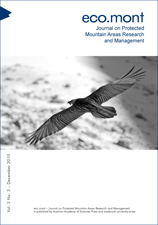Monika Paar
S. 44 - 44
doi:
10.1553/eco.mont-2-2s44
Verlag der Österreichischen Akademie der Wissenschaften
doi:
10.1553/eco.mont-2-2s44
Abstract:
Over the last ten years, the Austrian national parks experienced a period of intensive development. Major infrastructure and management projects were successfully completed during this time. The six national parks are now models of conservation in Austria. Eventually, the wealth of joint projects and cooperations exceeded existing capacities for efficient organization, coordination and implementation. The lack of a jointly agreed nationwide orientation of national park policy also made itself felt. It would only be a matter of time before individual national parks would veer off in different directions unless something was done about it. In several workshops, the Federal Ministry of Agriculture, Forestry, Environment and Water Management, together with the national parks, developed a strategy for the future of the Austrian national parks. Subsequently, this strategy was discussed with the federal states and NGOs (Austrian League for Nature Conservation, Austrian Association of Alpine Sports, Austrian Friends of Nature, Environment Umbrella Organization and WWF Austria) and expanded further. It focused on efficient organization and coordination of joint multi-park actions for the six national parks under the overall brand Nationalparks Austria.
2010/11/24 15:03:15
Object Identifier:
0xc1aa5576 0x0024d22f
Rights:https://creativecommons.org/licenses/by-nc-nd/4.0/
The journal “eco.mont” – Journal of protected mountain areas research and management – was published for the first time in June 2009.
The journal was founded as a joint initiative of the Alpine Network of Protected Areas (ALPARC), the International Scientific Committee on Research in the Alps (ISCAR), the Austrian Academy of Sciences (ÖAW) and the University of Innsbruck.
The journal aims to highlight research on and management issues in protected areas in the Alps without excluding other protected mountain areas in Europe or overseas. Its target audiences are scientists from all related disciplines, managers of protected areas and interested individuals including practitioners, visitors, teachers, etc.
The journal presents peer-reviewed articles in English by authors who research protected mountain areas and management issues within these areas. It's published twice a year as a collaboration of the Austrian Academy of Sciences Press – responsible for the e-version – and Innsbruck University Press – responsible for the print version.
Die Zeitschrift „eco.mont“ – Zeitschrift zur Forschung in Gebirgsschutzgebieten – erschien im Juni 2009 zum ersten Mal. Die Zeitschrift wurde auf Initiative des Netzwerks Alpiner Schutzgebiete (ALPARC), der Schweizer Akademie der Naturwissenschaften (ISCAR), der Österreichischen Akademie für Wissenschaft (ÖAW) und der Universität Innsbruck gegründet. Sie hat das Ziel, Themen zu behandeln, die gleichzeitig Forschung und Verwaltung in und über die Schutzgebiete der Alpen betreffen, ohne dabei andere Gebirgsschutzgebiete Europas oder anderswo auszuschließen. Diese neue Zeitschrift richtet sich an ein Publikum von Wissenschaftlern der verschiedensten Fachbereiche, an die Verwalter von Schutzgebieten und an alle sonstigen Interessierten, Praktiker, Besucher, Lehrpersonal etc. einbegriffen. Die Zeitschrift veröffentlicht begutachtete Beiträge auf Englisch von Autoren, die Fragen der Gebirgsschutzgebieten und deren Verwaltung forschen. Sie erscheint zweimal pro Jahr, auf der Basis der gemeinsamen Anstrengungen des Verlags der Österreichischen Akademie der Wissenschaften, der für die digitale Fassung verantwortlich ist, und der Presse der Universität Innsbruck, verantwortlich für die gedruckte Fassung.



 Home
Home
 Print
Print
 References
References
 Share
Share

